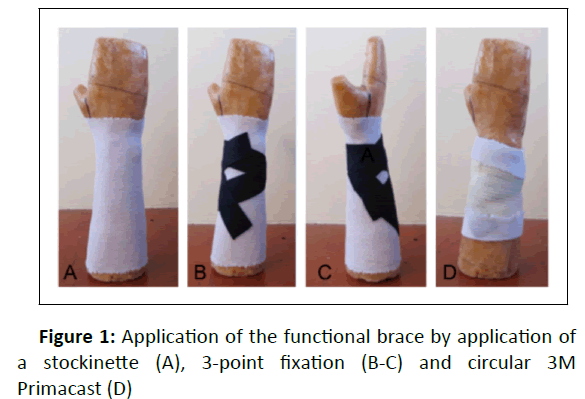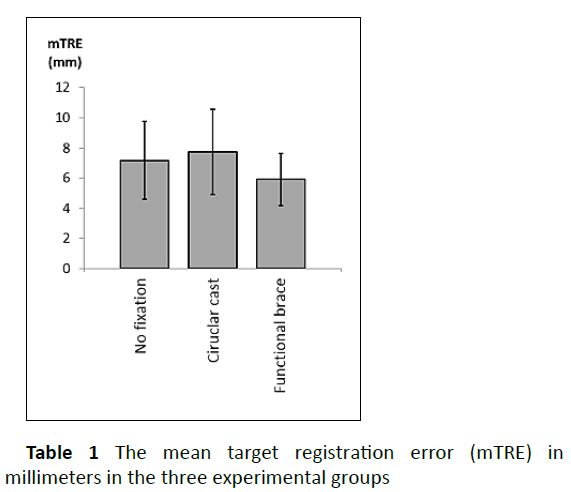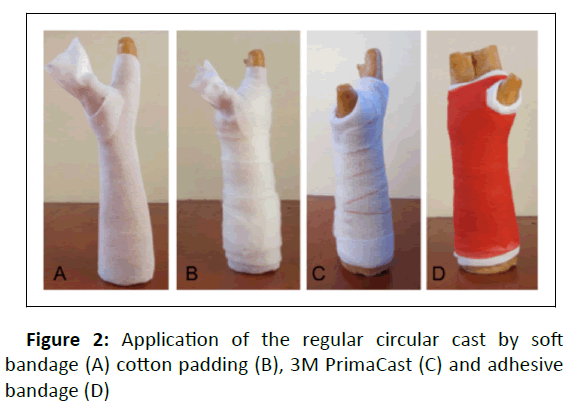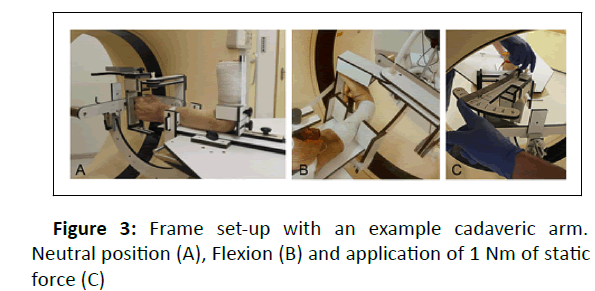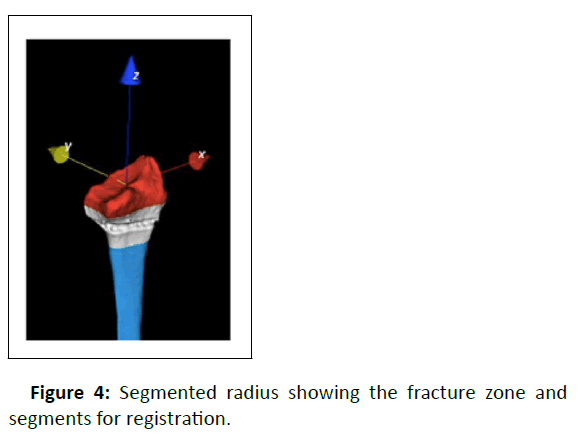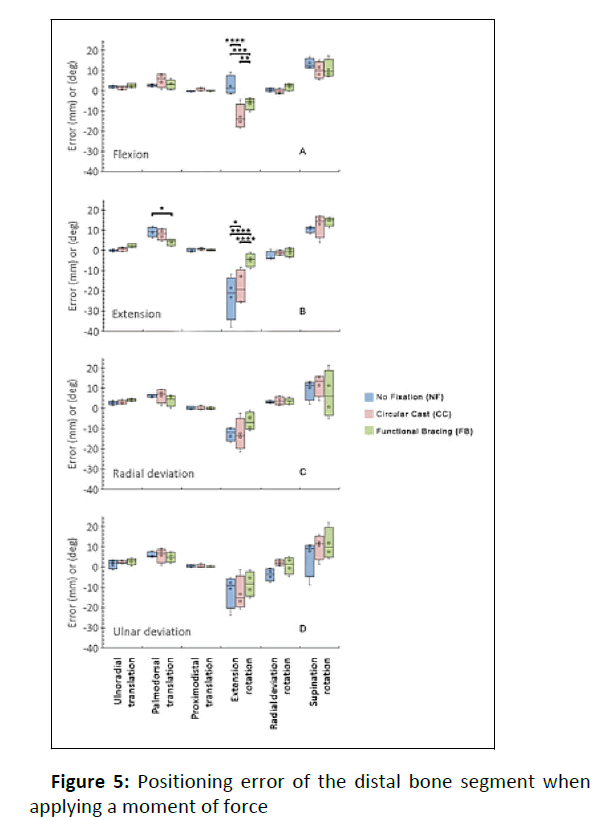Comparable Support by Functional Bracing in Extra-Articular Distal Radius Fractures: A Cadaveric Pilot Study
Bloemers FW1*, Rijsdijk M1, Dobbe JGG2, Veen AVD1, Streekstra GJ2 and Buijtenen JMV1
1Department of Surgery, University of Amsterdam, Amsterdam, The Netherlands
2Department of Biomedical Engineering and Physics, University of Amsterdam, Amsterdam, The Netherlands
- *Corresponding Author:
- Bloemers FW
Department of Surgery,
University of Amsterdam, Amsterdam,
The Netherlands,
E-mail: fw.bloemers@amsterdamumc.nlc
Received date: January 28, 2023, Manuscript No. IPJCEOP-22-13461; Editor Assigned date: January 31, 2023, PreQC No. IPJCEOP-22-13461 (PQ); Reviewed date: Feburary 12, 2023, QC No. IPJCEOP-22-13461; Revised date: Feburary 23, 2023, Manuscript No. IPJCEOP-22-13461 (R); Published date: Feburary 28, 2023, DOI: 10.36648/2471-8416.9.1.92
Citation: Bloemers FW, Rijsdijk M, Dobbe JGG, Veen AVD, Streekstra GJ, Buijtenen JMV (2022) Comparable support by functional bracing in extra-articular distal radius fractures: a cadaveric pilot study. J Clin Exp Orthopr Vol.9 No.1:92
Abstract
Objectives: Extra-articular distal radius fractures are often treated by circular casting. A functional brace, however, may equally support the fracture zone but adds early mobilization of the radiocarpal joint. Since the amount of fracture movement for different types of fixation is currently unknown, we investigate the degree of bone displacement in extra-articular distal radius fractures fixated by regular Circular Casting (CC), Functional Bracing (FB), and No-Fixation (NF).
Material and methods: In four cadaveric arms, an extraarticular distal radius fractures was simulated and immobilized by either CC, FB or NF. After creating an extraarticular distal radius fractures, the fracture was reduced anatomically and the arms were placed in a test frame. Hereafter, flexion, extension and deviation were then induced by a static moment of force of 1 Nm. The wrists were subsequently CT scanned and bone displacement was quantified.
Results: For the hand in flexion and extension, FB showed less bone rotation of the distal segment about the flexionextension axis compared to CC and NF. However, based on the overall displacement of the distal bone segment for different poses of the hand, we could not attribute a superior reduction of bone displacement to any type of fixation.
Conclusion: To conclude this study, stabilization of an extraarticular distal radius fractures by FB might provide comparable bone fixation compared to CC and NF.
Level of evidence: Foundational evidence, Level 4
Keywords
Functional brace; Distal radius fracture; Casting; Fix-4-Life; Cadaveric model
Introduction
Extra-Articular Distal Radius Fractures (EADRFx) are among the most commonly treated fractures [1]. Surgical treatment options are mainly intended for instable fractures or in patients demanding quicker recovery in the first 3 months after the trauma [2] whilst the majority of stable fractures warrant conservative treatment [3, 4]. Conservative treatment generally consists of semicircular casting for one week followed by 3 to 4 weeks of CC. The semicircular cast allows initial soft tissue swelling, but requires to be replaced after one week when swelling is reduced. Both casts provide immobilization of the fracture by bridging the fractured radius as well as the radiocarpal joint. Immobilization of the joint might lead to temporary post-immobilization stiffness of tendons, infections and nerve lesions [5] and in 1-37 % of patients, even to the development of Type 1 Complex Regional Pain Syndrome [6, 7]. After conservative cast therapy, a period of months of rehabilitation, often supervised by physiotherapy is needed in order to restore the functional outcome.
An alternative to the above described treatment is Functional Bracing (FB). FB allows early mobilization of the radiocarpal joint whilst immobilizing the fracture zone. This might possibly facilitate better functional outcomes [8] next to the avoidance of the aforementioned cast-related problems. Also, FB might lead to less frequent outpatient clinic visits by self-tightening of straps. However, the influence of a FB as well as regular Circular Casting (CC) or No-Fixation (NF) on bone movement in the fracture zone is currently unknown. In this experimental cadaver study, advanced CT based image analysis techniques are used to investigate the degree of bone fixation in EADRFx fixated by either FB, CC or NF, while applying a controlled moment of force to the wrist in flexion, extension, radial deviation and ulnar deviation.
In this cadaveric study, we investigate the degree of bone displacement in EADRFx fixated by either FB, CC or NF after inducing a static moment of force of 1 Nm in flexion, extension and deviation.
Materials and Methods
This study was approved by the local ethical review board (approval number 2017.098). All subjects included in this study donated their body to science and were anonymously included for subsequent analyses.
Specimens and preparation
Four anonymous cadaveric lower arms (4 right-sided adult arms, including the elbow joint and humerus) with no past medical history of previous fractures, joint diseases or osteoporosis were included. The adult, cadaveric arms were preserved with a Fix-for-life (F4L) solution (Fix for Life BV, Leliestraat 54, 2313 BH Leiden, The Netherlands). F4L is less detrimental than formaldehyde and therefore preserving more realistic and flexible tissue properties [9]. These features allow a realistic mechanical interaction between bone and soft tissues, such as tendons and muscles.
To simulate an EADRFx, a planar osteotomy was used. Through a modified Henry approach, the distal radius was exposed and an circumferential, extra-articular osteotomy perpendicular to the radial axis was sawed 20 millimeters proximal of the radiocarpal joint. No dorsal wedge was made in order not to disturb the functional ligamentotaxis of the extensor tendons. Hereafter, the bone was visually checked for complete cut and the flexor tendons were inspected for incidental lacerations, which did not occur. The fracture was manually reduced under direct visualization. Next, the distal radius was fixated by either FB, CC, or NF and subsequently strapped into the test frame.
Immobilization techniques
The FB used in this study consisted of a molded 3-point reinforcement, created with layered PrimaCast wraps (3M Primacast splint, 3M Company, St Paul Minnesota, USA) positioned at the dorsal part of wrist. The brace has a surface distally limited to the radius and ulna, allowing movement in the radiocarpal joint. The reinforcement is subsequently fixed with self-adhesive bandage or Velcro straps for easy appliance (Figure 1,1A).
In the CC, the skin is protected by a stockinette and padded with a circular cotton layer. A circular splint of PrimaCast (3M Primacast splint, 3M Company, St Paul Minnesota, USA) is applied proximal of the distal radius up distally reaching the metacarpal joints, slightly in ulnar deviation and volar flexion. The CC is fixated with self-adhesive bandage (Figure 2).
Evaluation setup
After performing the osteotomy as explained above, the arm was placed in a specially designed test frame and the humerus was strapped to the frame whilst the elbow joint was flexed in 90 degrees (Figure 3A). Rotation of the arm about the axis of the humerus was avoided by two delimiters just below the wrist level. The fingers were fixed in a grip. The frame allows the wrist joint to rotate in the flexion-extension or radioulnar axis, whilst keeping the proximal part of the upper arm fixed (Figure 3B). A Computed Tomography (CT) scan was first made of each arm in the test frame in neutral position without applying a load. This scan provided the relative position of the bone segments in the target position before applying any fixed moment of force (Figure 3C).
Since the free range of motion might be different for each cadaver specimen, it is likely that the required mechanical load will markedly increase if the wrist is forced beyond this free range of motion.
This will exert a higher force to the distal bone segment in turn resulting in a higher bone displacement, rendering the displacement dependent on the free range of motion. In our cadaver experiments we therefore chose to apply a fixed moment of force (1 Nm) to keep the hand in flexion, extension, radial deviation and ulna deviation. In case of extension motion this load in a cadaver specimen is comparable to holding a half full 1L bottle in the palm of the hand [5].
Displacement quanti ication
The degree in which the distal bone segment replaces with respect to the proximal bone segment was quantified with custom software as described by Dobbe et al [10, 11]. In short, the entire radius was segmented from the initial CT scan and provided a polygon mesh representing the radius.
The segments distal (red) and proximal (blue) of the fracture (Figure 4) were clipped and registered to subsequent scans of the loaded wrist in flexion, extension, radial and ulnar deviation.
The relative position of the distal bone segment with respect to the proximal bone segment in the loaded condition was compared with the position in the initial CT scan. Displacement was expressed in terms of three translations along and three rotations about the axes of an anatomical coordinate system defined in the same way for each radius.
The anatomical coordinate system (Figure 4) has its z-axis in the center of the radius, the x-axis is perpendicular to the z-axis and in the direction of the radial styloid. The yaxis is perpendicular to the x- and z-axes following the righthand rule. The origin of the coordinate system is placed where the zaxis intersects the distal radius.
Finally, the mean target registration error (mTRE) was determined, representing the average distance between corresponding points in the mesh of the distal bone segment in the initial and in the loaded position. Ideally, this mTRE value should be 0.0 mm (no dislocation). Both position changes and mTRE were determined for the conditions where the arms were fixed by FB, CC, or NF.
Statistical analysis
The mean differences of translational or rotational errors were reciprocally compared using the Tukey's multiple comparisons test and unpaired T-testing. For the mean target registration error (mTRE), the One-way Anova test was applied for mutual comparison. A P-value < 0.05 was considered significant.
Results
The main outcomes of displacement of the fracture after application of a fixed moment of force of 1 Nm are presented in Figure 5. The displacement of the distal bone segment with respect to the proximal bone is demonstrated in case the wrist was moved toward flexion (Figure 5A), extension (Figure 5B), radial deviation (Figure 5C) or ulnar deviation (Figure 5D), for the three types of immobilization (i.e., no fixation (NF), circular cast fixation (CC), or functional brace fixation (FB)). The positioning error is shown in terms of three translations (mm), in the ulnoradial, palmodorsal, and proximodistal direction, and in terms of three rotations (degrees) in the extension, radial deviation, and supination direction. Closer to 0 means less translation or rotation. The boxplots (N=4) show the 25-75% quartile range, the whiskers represent the full range. The dots and the full range limits represent the individual measurement results.
*P<0.05, ** P<0.01, ***P<0.001, ****P<0.0001
In flexion, a significant difference in displacement in extension-rotation was observed between NF (mean 2.5) and CC (mean -12.8) (P < 0.0001) and also between NF versus FB (mean –6.2) both favoring NF (P <0.001, Figure 5A). Comparison of CC and FB showed a significant difference of -6.6 degrees, favoring FB (P = 0.007).
Positioning of the joint in extension leads to a significant difference of 5.1 mm in palmodorsal translation between NF (mean 9.2) and FB (mean 4.1) in favor of FB (P < 0.05, Figure 5B). Also, a significant difference (P < 0.0001) in extension-rotation of -4.8 degrees was observed between NF (mean -23.0 degrees) and CC (mean -18.1 degrees) favoring CC. Next to this, significant differences were seen in extension-rotation between NF and FB (mean -4.7) of 18.2 degrees favoring FB and between CC and FB (mean difference -13.4) favoring FB (P < 0.0001).
Both ulnar- and radial deviation did not show any significant differences between the types of fixation (Figure 5C&D).
The combination of all aforementioned displacement parameters, i.e., the average positioning error of four poses in four arms, is expressed in terms of the mTRE in a bar graph and did not show a statistically significant positioning difference between all types of immobilization (P >0.05).
Discussion
This study objectively measured bone displacement in EADRFx after applying a static moment of force. Simulating EADRFx in cadaveric arms enabled comparing the degree of fixation by FB, CC and NF. Overall, the three fixation types were comparable by showing minimal differences in mTRE. This demonstrates that support by either FB or CC in EADRFx is comparable to NF. Especially extension-rotation and supination-rotation displacements were observed during all movements in contrast to translation displacements. Any form of fracture fixation (CC and FB) seem to induce fracture-rotations during flexion and extension. However in FB, extension-rotation seem to be significantly less compared to CC.
CC is currently the standard of care in stable fractures and its main purpose is believed to rigidly immobilize the wrist fracture. However, previous studies based on radiographic outcome, showed that standard casts do not provide absolute fracture fixation and often result in malunion by shortening of the fracture, loss of inclination, and secondary dislocation [12]. In our study, CC demonstrated comparable translation of the distal bone segment compared to FB and NF. This underlines the previous results where no definitive stabilization of the fracture zone was found. This pilot study did not demonstrate a difference between using FB, CC or NF. Increasing the number of specimens may demonstrate otherwise, but fracture fixation could as well be similar. We recommend using more cadaver specimens in a future study to be able to confirm or reject our findings.
Several previous studies have evaluated the treatment of distal radius fractures by FB [13, 14, 15, 16]. Although FB was already described by Sarmiento et al. in 1975, FB is still not applied in daily clinical practice. Functional outcomes after FB were studied in both EADRFx and intra-articular fractures. Overall, the functional results were ‘good to excellent’ [13, 14]. When comparing FB to CC, equal functional results were found after 7 weeks and 3 months [13, 15]. Strikingly, some symptoms of radial nerve irritation were found in 7.7% of the patients treated with FB although most of these resolved spontaneously [16]. A randomized controlled trial demonstrated that FB is effective for distal radial fractures, even after manipulation of the fracture zone. Indeed, movement of the wrist resulted in better grip and strength while functional outcomes were comparable to CC [17]. These clinical studies underscore the results found in our cadaveric study by demonstrating comparable functional outcomes between FB and CC.
The main advantage of the FB used in our cadaveric study is allowing full range of motion of the wrist joint while dorsally supporting the EADRFx zone. In vivo, use of the wrist will probably be restricted initially by fracture pain, limiting use of the arm. Additionally, healing of the fracture zone over time will result in less pain and possibly to a natural usage of the wrist over time with FB, while this advantage is not effective in CC. Clinical studies are needed to confirm this potential advantage in FB.
In this cadaveric study, investigation of the role of edema caused by contused soft tissues surrounding the fractured bone could not be studied. Some initial edema might provide, in combination with a form of circular support, additional internal fixation of the fracture in patients by hydraulic compressive forces (Pascal’s principle [18]). When edema diminishes, loosening of the cast might occur, leading to secondary dislocation of the fracture. Interestingly, a FB can easily be tightened by Velcro straps while leaving the fracture zone unaffected. In our study, fixation by either FB or CC resulted in similar translation and rotation, even comparable to no fixation. This puts the role of fixation by either FB of CC in perspective and questions the effect of immobilization of the fracture zone. Therefore, FB would be a more patient friendly option, since it gives comparable support, leads to similar functional outcomes and allows earlier movement of the wrist joint. As such, FB could be a potential alternative to CC and might result in less stiffness of the radiocarpal joint.
Besides the small number of cadaveric arms used, several limitations of this study should be addressed. In this experimental study only static end movements of flexion, extension, and ulnar and radial deviation were measured by CT scan. Therefore, progressive fracture dislocation possibly caused by repeated movements of the joint or contributing effect of active ligamentotaxis could not be studied. The osteotomy used in this study simulates an EADRFx and was created by a clear horizontal cut two centimeters proximal of the joint. This may have overestimated the observed dislocations compared to in vivo fractures in which the fracture surfaces may be rough hereby-limiting secondary dislocations. On the other hand, the approach may be considered a worst-case scenario showing similar dislocations between FB and CC
Conclusion
In this cadaveric experiment, immobilization of an EADRFx by FB provides comparable bone fixation compared to CC and NF and less extension-rotation displacement. The allowed movement of the radiocarpal joint in FB might be a compelling advantage in patients avoiding stiffness and induced postimmobilization physiotherapy. Additional prospective human studies, including patient related outcome measurements are needed to confirm the equal fixation abilities of FB
Acknowledgements
We would like to thank Wim Schreurs for providing the testframe and Laura Meijer for her assistance with the statistical analysis.
Compliance with ethical standards`
Declarations
Conflict of interests:`
The authors declare that they have no conflict of interest.
Funding:
The author(s) received no financial support for the research, authorship, and/or publication of this article.
Ethical treatment of human subjects
Ethical approval for this cadveric study was obtained from: Toetsingscommissie Biobank, Amsterdam UMC, VU University Amsterdam, De Boelelaan 1117, 1081 HV Amsterdam, 2017.098 (06-07-2017)
Availability of data and materials
The datasets used and/or analyzed during the current study are available from the corresponding author on reasonable request.
Authorship
All authors reviewed and edited the manuscript and approved the final version of the manuscript and share responsibility and accountability of the results. All authors have made substantial contributions to the four categories established by the International Committee of Medical Journal Editors.
Study concept and design: JB, MR, AV, JD, GS, FB
Acquisition, analysis or interpretation of data: JB, MR, AV, JD, GS, FB
Drafting the manuscript: JB, JD, GS, FB
Critical revision of the manuscript for important intellectual content: JB, MR, JD, GS, FB
Statistical analysis: JB, JD, GS, FB
Administrative, technical or material support: JB, MR, AV, JD, GS, FB
Study supervision: JB, AV, JD, GS, FB
References
- Meena S, Sharma P, Sambharia AK, Dawar A (2014) Fractures of distal radius: an overview. J Family Med Prim Care 3:325-332.
[Crossref], [Google Scholar]
- Vannabouathong C, Hussain N, Guerra-Farfan E, Bhandari M (2019) Interventions for Distal Radius Fractures: A Network Meta-analysis of Randomized Trials. J Am Acad Orthop Surg 27: e596-e605.
[Crossref], [Google Scholar]
- Anzarut A, Johnson JA, Rowe BH, Lambert RG, Blitz S, Majumdar SR (2004) Radiologic and patient-reported functional outcomes in an elderly cohort with conservatively treated distal radius fractures. J Hand Surg Am 29:1121-1127.
[Crossref], [Google Scholar]
- Beumer A, McQueen MM (2003) Fractures of the distal radius in low-demand elderly patients: closed reduction of no value in 53 of 60 wrists. Acta Orthop Scand 74: 98-100.
[Crossref], [Google Scholar]
- Bruyere A, Vernet P, Botero SS, Igeta Y, Hidalgo Diaz JJ, Liverneaux P (2018). Conservative treatment of distal fractures after the age of 65: a review of literature. Eur J Orthop Surg Traumatol 28:1469-1475.
[Crossref], [Google Scholar]
- Jellad A, Salah S, Ben Salah Frih Z (2014). Complex regional pain syndrome type I: incidence and risk factors in patients with fracture of the distal radius. Arch Phys Med Rehabil 95:487-492.
[Crossref], [Google Scholar]
- Ydreborg K, Engstrand C, Steinvall I, Larsson EL. Hand function, experienced pain, and disability after distal radius fracture. Am J Occup Ther 2015;69:6901290030.
[Crossref], [Google Scholar]
- Handoll HH, Madhok R. Conservative interventions for treating distal radial fractures in adults. Cochrane Database Syst Rev 2003;10.1002/14651858.CD000314CD000314.
[Crossref], [Google Scholar]
- Holewijn RM, Faraj SSA, Kingma I, van Royen BJ, de Kleuver M, van der Veen AJ (2017). Spinal biomechanical properties are significantly altered with a novel embalming method. J Biomech 55:144-146.
[Crossref], [Google Scholar]
- Caiti G, Dobbe JGG, Bervoets E et al (2019). Biomechanical considerations in the design of patient-specific fixation plates for the distal radius. Med Biol Eng Comput 57:1099-1107.
[Crossref], [Google Scholar]
- Dobbe JG, Strackee SD, Schreurs AW et al (2011) Computer-assisted planning and navigation for corrective distal radius osteotomy, based on pre- and intraoperative imaging. IEEE Trans Biomed Eng p58:182-190.
[Crossref], [Google Scholar]
- Sarmiento A, Zagorski JB, Sinclair WF (1980) Functional bracing of Colles' fractures: a prospective study of immobilization in supination vs. pronation. Clin Orthop Relat Res 175-183.
[Crossref], [Google Scholar]
- Bunger C, Solund K, Rasmussen P (1984). Early results after Colles' fracture: Functional bracing in supination vs dorsal plaster immobilization. Arch Orthop Trauma Surg 103: 251-256.
[Crossref], [Google Scholar]
- Sarmiento A, Pratt GW, Berry NC, Sinclair WF (1975). Colles' fractures. Functional bracing in supination. J Bone Joint Surg Am 57:311-317.
[Crossref], [Google Scholar]
- Solgaard S, Bunger C, Sllund K (1990) Displaced distal radius fractures. A comparative study of early results following external fixation, functional bracing in supination, or dorsal plaster immobilization. Arch Orthop Trauma Surg 109: 34-38.
[Crossref], [Google Scholar]
- Stewart HD, Innes AR, Burke FD(1984) Functional cast-bracing for Colles' fractures. A comparison between cast-bracing and conventional plaster casts. J Bone Joint Surg Br 66: 749-753.
[Crossref], [Google Scholar]
- Tumia N, Wardlaw D, Hallett J, Deutman R, Mattsson SA, Sanden B (2003) Aberdeen Colles' fracture brace as a treatment for Colles' fracture. A multicentre, prospective, randomised, controlled trial. J Bone Joint Surg Br 85: 78-82.
[Crossref], [Google Scholar]
- Sarmiento A, Latta L, Zilioli A, Sinclair W (1974). The role of soft tissue in the stabilization of tibial fractures. Clin Orthop Relat Res 116-129.
[Crossref], [Google Scholar]
Open Access Journals
- Aquaculture & Veterinary Science
- Chemistry & Chemical Sciences
- Clinical Sciences
- Engineering
- General Science
- Genetics & Molecular Biology
- Health Care & Nursing
- Immunology & Microbiology
- Materials Science
- Mathematics & Physics
- Medical Sciences
- Neurology & Psychiatry
- Oncology & Cancer Science
- Pharmaceutical Sciences
